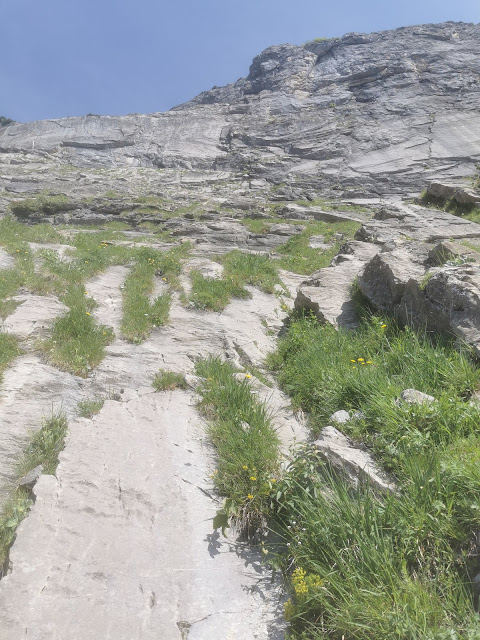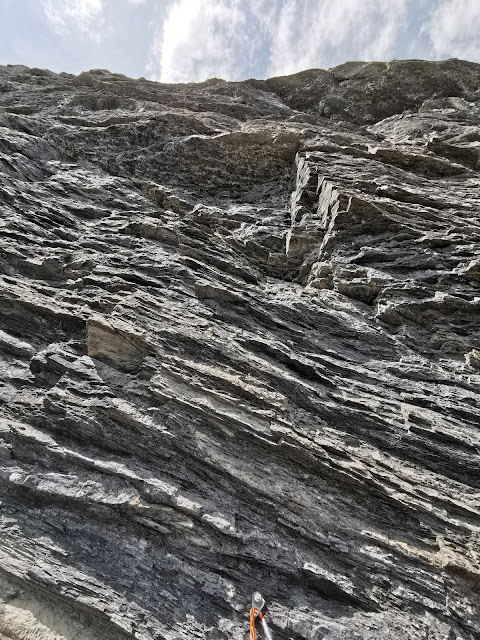Gonzen - Ä guats Gfühl (VII)
The Gonzen south-face at Sargans makes quite an impression on the surrounding valley, and indeed hosts some big-wall-like lines up to 20 pitches. Still, it sits at low altitude, which makes it an interesting target for the early, and late seasons. So the route Ä guats Gfühl (20 pitches mostly V-VI, sometimes VII) came handy, when Miriam wished for a long, and flowy outing without the need to drive long hours from Zurich.
 |
| View of Gonzen from the Pizol webcam. |
The approach from the parking a bit after Unter Prod (P.731) is quite straightforward, and covers about 500 meters in height via Cholplatz (P.1155). From Cholplatz follow the path to the west, and eventually ascend to about 1260m to reach the base of the route.
L1 VI
Start at the left-facing dihedral with faint lettering. Long pitch, stretches 50m. Immediately, my respect for the smooth Gonzen slabs was renewed, in particular as our most recent outing had been on Gneiss rock, which feels much grippier. The corner helps, but at the crux move the holds are particularly hard to discover. Besides this well-protected move, the remaining pitch is quite friendly. Moreover, some of the lacking friction might have been rather mental, as Miri followed with the words "es hebt scho guet..." (it sticks quite well).
 |
| The left-facing, slabby corner of pitch 1 (VI). |
L2 IV+
Grassy pitch with sparse protection, so that the main challenge is to remain on track. Miriam read it well, and led this one nicely. Besides the walking, there is a single step to be climbed.
 |
| Grassy pitch 2 (IV+). |
L3 VI-
The rock becomes more compact again, and offers some nice moves on slabs, and spaced protection where the slabs get easy enough. By now, I had calibrated my sense for friction, and smearing felt considerably more solid than during the first pitch.
L4 VI
Nice opening with underclings, and slabby steps, second half grassy, run-out, and easy.
 |
| Nice start on underclings in pitch 4 (VI) |
Short, but sustained face climbing along a wide, jagged crack. I experienced a little surprise when I did a dynamic move to a hold which I though was good, but turned out pretty slopy...fortunately I stuck it with enough stability from my other points of contact with the rock, so that it resolved gracefully. Overall, this section turned out pretty tricky, as there are few positive holds, and even fewer in horizontal position. Lastly, a bit sketchy through wet grass to the belay.
 |
| In pitch 5 (VI) the route follows the jagged crack in the center of the picture, and then goes right towards the obvious corners. |
L6 VII #2
The former crux pitch, which starts along a steep corner. The crux consists of climbing around the following arete. The rock is difficult to read, and it takes a moment to identify a passable sequence. The finale brings you up, and around yet another arete, along steep, and juggy cracks. It is possible, and makes sense, to protect the top-out with a BD #2 cam, also because the best holds are also the loosest. Note: belay consists of only one bolt, and a thread! If marching on mindlessly (like me), you end up belaying from a single bolt...
 |
| Looking back at the start of L7 (IV+) - having overlooked the belay after L6 (VII). |
L7 IV+
Slabby traverse, fairly easy, and reasonably well protected.
 |
| Miriam following in the traverse pf pitch 7 (IV+). |
L8 VIII- (!)
The ominous single-move crux of the route. It waits at the first bolt, which is by itself not as easy to approach as you might think. But once clipped, you can inspect the situation from good underclings, and indeed there is an ok-crimp somewhere on the right hand side, which allows to free this move with moderate effort. The rest of this pitch is relatively easy, and follows a nice gully. Note: This pitch is already subject to rockfall from the big chossy ledge above!
 |
| The nominal one-move crux of the route (VIII-) at the start of pitch 8. |
L9 V (!!)
After a slabby initial section, this pitch climbs the pillar to the right. Note: Beware of rockfall, and try to minimize your exposure time, in particular, if parties are climbing ahead! Rockfall is a serious issue here.
 |
| The big gully of pitch 9 (V), which is strongly exposed to rockfall. |
L10 I
The first of five scrambling pitches through grass, and choss. We climbed these pitches simultaneously. Along the way, the belays, and some fixed protection can be clipped.
 |
| Pitches 10 (I) to 13 (II) cover the big ledge towards the headwall. |
L11 IV #0.75
Follow the traces, leading along a ramp to the right hand-side. A few marker bolts assure that you are on the right path.
L12 II (!)
Keep going up pretty straight (towards 11 o'clock). Be careful not to cause rockfall!
L13 II (!)
Keep going up pretty straight (towards 11 o'clock). Be careful not to cause rockfall! I ended up pretty much exactly at the belay of Gonzo, which is equipped with two well visible biners.
L14 I
From the belay of Gonzo, traverse/ascend along the base of the headwall, until you meet a low pair of bolts. Shortly before that (10m), there is another bolt on the ground. Just after the belay, there are also several bolts on the ground. A small roof above the belay also helps to identify the right location.
 |
| Looking back at the chossy pitch 14 (I). |
L15 VII-
The steep face looks slightly intimidating! At least, alpinistically minded people could be tempted to look for a more logical line around the corner (Südgrat). But contenders for Äs guets Gfühl will appreciate the athletic challenge, and indeed, it is really good! I thought the moves over the first two bolts were tricky, but they went quite alright. The traverse under the roof also goes nicely with a bit of consideration, and afterwards it's pretty much a jug fest to the belay.
 |
| Lots of options to hold on to in steep pitch 15 (VII-). |
L16 VII (6a++) #0.75
In 2020 a major rockslide had removed a considerable part of this pitch, but Daniel Benz was quick to re-establish this pitch along a new line to the left. I did not know the previous pitch, but the new one is beefy! At least for me, it felt very sustained, and pretty difficult. Also, the hardest move felt considerably harder than the VIII- move in pitch 8, but maybe I read it the wrong way. In terms of quality, this pitch stands out from the rest, but so it does for difficulty. The protection is fair, but rather mandatory, too.
 |
| Looking back at the sustained pitch 16 (6a++) which was bolted only recently to replace the old, fallen pitch (to the left in the picture). |
L17 V+ (6b)
In continuation of the new line, this pitch also got a face-lifting (no pun intended), and mostly leads through compact rock now. The short crux is just at the first bolt, a burly-crimpy boulder to establish yourself on the face. After that move, the difficulties are pretty over, and you swiftly reach the comfortable belay on the grass-ledge. Even though the crux move is quite pronounced, I thought that pitch 16 (6a+) was harder.
L18 III
Sparsely protected grass climbing to the final head wall. Miriam's lead was once again flawless :) It is to say, though, that some moves would probably not fit the modern idea of grade 3. Look for the belay towards 11 o'clock. Note: Apparently, an alternative pitch has been bolted a few meters down to the right (Note: new, independent line of Äs guets Gfühl). Turned out that I had overinterpreted last bolt of the old L17 as a new pitch.
L19 VI #1
Steep corner, and airy traverse. The hardest moves in the corner felt quite mandatory, and I did not notice much potential for solid protection. Anyway, if you arrive at this point, this sequence won't be much of a showstopper. At the beginning of the traverse, a BD cam #1 can be of good service to your follower. The traverse is exposed, but pretty well protected, and juggy to climb. Edit: The new, independent line goes right, and straight through the face (6b).
 |
| Airy traverse in pitch 19 (VI), the difficulties are found earlier in a steep corner. |
L20 V
Hmm...the bolts just above the belay don't exactly promise grade V terrain - should we go around the corner, which hosts a much more accessible looking gully? We decided for the latter, which I think makes sense in the context of the route. But later I learned that during the renovation of pitches 16+17, the renovators also made an effort to make the classic Südgrat, and Äs guets Gfühl independent from each other. While it makes sense to me to provide a more attractive alternative to the grassy pitch 18, I thought the original final pitch along the gully was actually quite nice, and logical (the new line looked much harder - edit: 6b+). In any case, pay attention to rope drag, this pitch stretches 50m, and goes around a couple of corners!
 |
| Celebrating the at top out with a wonderful view! |
Approach: 1:00 h
Climbing: 8:30 h
Descent: 1:30 h
Total: 11:30 h
Gear: BD C4 #0.75-#2 make sense, more is likely too much.
Beauty/Protection: ***/xxx
Long, alpine outing through a big wall. Half of the pitches are rather rustic, but the rest offers decent rock, and interesting climbing. The view from the top definitely deserves five stars!



Kommentare
Kommentar veröffentlichen